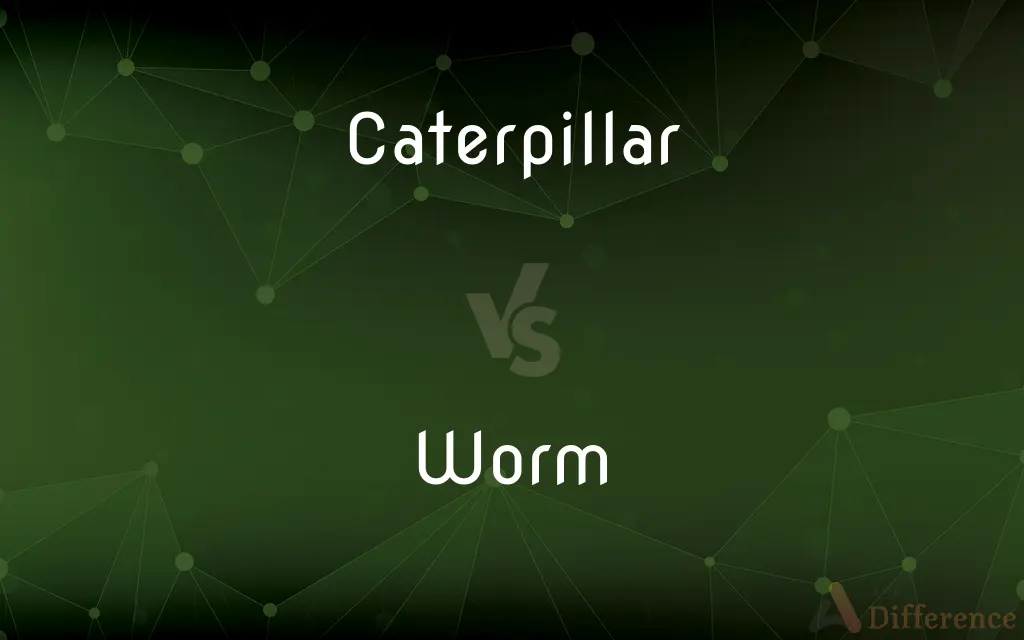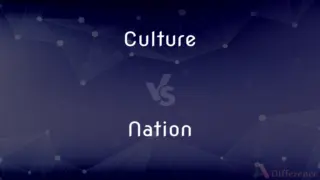Caterpillar vs. Worm — What's the Difference?
By Fiza Rafique & Maham Liaqat — Updated on March 19, 2024
Caterpillars are the larval stage of butterflies and moths, characterized by their segmented bodies and many legs, whereas worms are elongated, soft-bodied invertebrates, often with fewer distinct features.

Difference Between Caterpillar and Worm
Table of Contents
ADVERTISEMENT
Key Differences
Caterpillars, the larval stage of butterflies and moths (order Lepidoptera), are known for their distinct, often colorful appearance and several pairs of prolegs, which aid in their movement. On the other hand, worms represent a broad group of invertebrate animals, including earthworms, nematodes, and annelids, which generally have elongated, tube-like bodies without limbs.
Caterpillars are specifically adapted for a life of feeding on plant material, with powerful jaws for chewing leaves. They are often found on the plants they consume, making them easy to spot in gardens and forests. Worms, such as earthworms, have a diet that consists mainly of soil and organic matter, which they consume to aid in nutrient cycling within the soil. Their presence is crucial for maintaining healthy soil structure and fertility.
Caterpillars are equipped with various defense mechanisms against predators, including camouflage, toxic hairs or spines, and warning colors to deter birds and other predators. In contrast, worms rely on their environment for protection, burrowing into the soil or substrate to avoid predation. Some worms, like certain nematodes, can also produce toxins or unpleasant tastes to deter predators.
In terms of habitat, caterpillars are found primarily on or near their food plants in terrestrial environments. Worms have a broader range of habitats, from terrestrial to aquatic environments, including freshwater, marine, and even extreme environments like hydrothermal vents, demonstrating their adaptability and ecological diversity.
Comparison Chart
Classification
Larval stage of butterflies and moths (Lepidoptera)
Broad group of invertebrate animals (various phyla)
ADVERTISEMENT
Body Features
Segmented bodies, many legs, often colorful
Elongated, soft-bodied, fewer or no legs
Diet
Primarily leaves
Soil, organic matter, or diverse depending on species
Defense Mechanisms
Camouflage, toxic hairs/spines, warning colors
Burrowing, toxins, unpleasant tastes
Habitat
Terrestrial, on/near food plants
Terrestrial to aquatic, including extreme environments
Compare with Definitions
Caterpillar
Larval stage of butterflies and moths, known for feeding on leaves.
The monarch caterpillar feeds exclusively on milkweed plants.
Worm
Inhabit diverse environments, from soil to hydrothermal vents.
Tubeworms thrive in the extreme conditions of hydrothermal vents.
Caterpillar
Characterized by a segmented body and multiple pairs of legs.
Caterpillars use their prolegs to grip onto plant surfaces.
Worm
Elongated, soft-bodied invertebrates with a variety of lifestyles.
Earthworms play a crucial role in soil health.
Caterpillar
Possesses defense mechanisms like toxic hairs to deter predators.
The caterpillar's bright colors warn predators of its toxicity.
Worm
Lacks limbs and has a simple body structure.
Worms move through soil or water using their muscular body.
Caterpillar
Found primarily on or near their food source in terrestrial environments.
You can often find caterpillars on the undersides of leaves.
Worm
Diet varies widely, from soil to parasitism in other organisms.
Nematodes can be found in diverse environments, including as parasites.
Caterpillar
Caterpillars ( CAT-ər-pil-ər) are the larval stage of members of the order Lepidoptera (the insect order comprising butterflies and moths). As with most common names, the application of the word is arbitrary, since the larvae of sawflies are commonly called caterpillars as well.
Worm
Worms are many different distantly related animals that typically have a long cylindrical tube-like body, no limbs, and no eyes. Worms vary in size from microscopic to over 1 metre (3.3 ft) in length for marine polychaete worms (bristle worms), 6.7 metres (22 ft) for the African giant earthworm, Microchaetus rappi, and 58 metres (190 ft) for the marine nemertean worm (bootlace worm), Lineus longissimus.
Caterpillar
The wormlike larva of a butterfly or moth.
Worm
Any of various invertebrates, especially an annelid, flatworm, nematode, or nemertean, having a long, flexible, rounded or flattened body, often without obvious appendages.
Caterpillar
Any of various insect larvae similar to those of the butterfly or moth.
Worm
Any of various crawling insect larvae, such as a grub or a caterpillar, having a soft elongated body.
Caterpillar
The larva of a butterfly or moth; leafworm
The bird just ate that green caterpillar.
Worm
Any of various other animals, such as a shipworm or a slowworm, having a long slender limbless body.
Caterpillar
A vehicle with a caterpillar track; a crawler
Worm
Something, such as the thread of a screw or the spiral condenser in a still, that resembles a worm in form or appearance.
Caterpillar
(maths) A set of subtrees of a tree
Worm
The spirally threaded shaft of a worm gear.
Caterpillar
The larval state of a butterfly or any lepidopterous insect; sometimes, but less commonly, the larval state of other insects, as the sawflies, which are also called false caterpillars. The true caterpillars have three pairs of true legs, and several pairs of abdominal fleshy legs (prolegs) armed with hooks. Some are hairy, others naked. They usually feed on leaves, fruit, and succulent vegetables, being often very destructive, Many of them are popularly called worms, as the cutworm, cankerworm, army worm, cotton worm, silkworm.
Worm
An insidiously tormenting or devouring force
“felt the black worm of treachery growing in his heart” (Mario Puzo).
Caterpillar
A plant of the genus Scorpiurus, with pods resembling caterpillars.
Worm
A person regarded as pitiable or contemptible.
Caterpillar
A wormlike and often brightly colored and hairy or spiny larva of a butterfly or moth
Worm
Worms Medicine Infestation of the intestines or other parts of the body with parasitic worms; helminthiasis.
Caterpillar
A large vehicle that is driven by caterpillar tracks; frequently used for moving earth in construction and farm work
Worm
(Computers) A malicious program that replicates itself until it fills all of the storage space on a drive or network.
Worm
To make (one's way) with the sinuous crawling motion of a worm.
Worm
To work (one's way or oneself) subtly or gradually; insinuate
She wormed her way into his confidence.
Worm
To elicit by artful or devious means. Usually used with out of
Wormed a confession out of the suspect.
Worm
To treat for intestinal worms
Wormed the dog.
Worm
(Nautical) To wrap yarn or twine spirally around (rope).
Worm
To move in a manner suggestive of a worm.
Worm
To make one's way by artful or devious means
He can't worm out of this situation.
Worm
A generally tubular invertebrate of the annelid phylum; an earthworm.
Worm
More loosely, any of various tubular invertebrates resembling annelids but not closely related to them, such as velvet worms, acorn worms, flatworms, or roundworms.
Worm
(archaic) A type of wingless "dragon", especially a gigantic sea serpent.
Worm
Either a mythical "dragon" (especially wingless), a gigantic sea serpent, or a creature that resembles a Mongolian death worm.
Worm
A contemptible or devious being.
Don't try to run away, you little worm!
Worm
(computing) A self-replicating program that propagates through a network.
Worm
(cricket) A graphical representation of the total runs scored in an innings.
Worm
Anything helical, especially the thread of a screw.
Worm
A spiral instrument or screw, often like a double corkscrew, used for drawing balls from firearms.
Worm
The spiral wire of a corkscrew.
Worm
(anatomy) A muscular band in the tongue of some animals, such as dogs; the lytta.
Worm
The condensing tube of a still, often curved and wound to save space.
Worm
A short revolving screw whose threads drive, or are driven by, a worm wheel or rack by gearing into its teeth.
Worm
(obsolete) Any creeping or crawling animal, such as a snake, snail, or caterpillar.
Worm
(figuratively) An internal tormentor; something that gnaws or afflicts one’s mind with remorse.
Worm
(math) A strip of linked tiles sharing parallel edges in a tiling.
Worm
(anatomy) The lytta.
Worm
(preceded by definite article) A dance, or dance move, in which the dancer lies on the floor and undulates the body horizontally thereby moving forwards.
Worm
(transitive) To make (one's way) with a crawling motion.
We wormed our way through the underbrush.
Worm
(intransitive) To move with one's body dragging the ground.
Worm
To work one's way by artful or devious means.
Worm
To work (one's way or oneself) (into) gradually or slowly; to insinuate.
He wormed his way into the organization.
Worm
To effect, remove, drive, draw, or the like, by slow and secret means.
Worm
To drag out of, to get information that someone is reluctant or unwilling to give (through artful or devious means or by pleading or asking repeatedly).
Worm
To fill in the contlines of (a rope) before parcelling and serving.
Worm and parcel with the lay; turn and serve the other way.
Worm
(transitive) To deworm (an animal).
Worm
(transitive) To cut the worm, or lytta, from under the tongue of (a dog, etc.) for the purpose of checking a disposition to gnaw, and formerly supposed to guard against canine madness.
Worm
(transitive) To clean by means of a worm; to draw a wad or cartridge from, as a firearm.
Worm
A creeping or a crawling animal of any kind or size, as a serpent, caterpillar, snail, or the like.
There came a viper out of the heat, and leapt on his hand. When the men of the country saw the worm hang on his hand, they said, This man must needs be a murderer.
'T is slander,Whose edge is sharper than the sword, whose tongueOutvenoms all the worms of Nile.
When Cerberus perceived us, the great worm,His mouth he opened and displayed his tusks.
Worm
Any small creeping animal or reptile, either entirely without feet, or with very short ones, including a great variety of animals; as, an earthworm; the blindworm.
Worm
An internal tormentor; something that gnaws or afflicts one's mind with remorse.
The worm of conscience still begnaw thy soul!
Worm
A being debased and despised.
I am a worm, and no man.
Worm
Anything spiral, vermiculated, or resembling a worm
The threads of screws, when bigger than can be made in screw plates, are called worms.
Worm
A spiral instrument or screw, often like a double corkscrew, used for drawing balls from firearms.
Worm
To work slowly, gradually, and secretly.
When debates and fretting jealousyDid worm and work within you more and more,Your color faded.
Worm
To effect, remove, drive, draw, or the like, by slow and secret means; - often followed by out.
They find themselves wormed out of all power.
They . . . wormed things out of me that I had no desire to tell.
Worm
To cut the worm, or lytta, from under the tongue of, as a dog, for the purpose of checking a disposition to gnaw. The operation was formerly supposed to guard against canine madness.
The men assisted the laird in his sporting parties, wormed his dogs, and cut the ears of his terrier puppies.
Worm
To wind rope, yarn, or other material, spirally round, between the strands of, as a cable; to wind with spun yarn, as a small rope.
Ropes . . . are generally wormed before they are served.
Worm
Any of numerous relatively small elongated soft-bodied animals especially of the phyla Annelida and Chaetognatha and Nematoda and Nemertea and Platyhelminthes; also many insect larvae
Worm
A person who has a nasty or unethical character undeserving of respect
Worm
A software program capable of reproducing itself that can spread from one computer to the next over a network;
Worms take advantage of automatic file sending and receiving features found on many computers
Worm
Screw thread on a gear with the teeth of a worm wheel or rack
Worm
To move in a twisting or contorted motion, (especially when struggling);
The prisoner writhed in discomfort
The child tried to wriggle free from his aunt's embrace
Common Curiosities
How do caterpillars defend themselves?
Caterpillars use camouflage, toxic hairs or spines, and warning colors to deter predators.
What distinguishes a caterpillar from a worm?
Caterpillars are the larval stage of butterflies and moths with segmented bodies and legs, while worms are a diverse group of invertebrates with elongated, soft bodies.
Is the life cycle of a worm as complex as that of a caterpillar?
Worm life cycles vary, but they generally do not undergo the complete metamorphosis seen in caterpillars.
Do all worms have the same diet?
No, worms have varied diets; for example, earthworms consume soil and organic matter, while some nematodes are parasitic.
Do worms play a role in agriculture?
Yes, earthworms are beneficial for soil health, aiding in aeration, drainage, and nutrient cycling, which can enhance crop growth.
Can caterpillars live in water?
Caterpillars are terrestrial and live on land, primarily on the plants they feed on, unlike some worms that can live in aquatic environments.
Are all caterpillars colorful?
While many caterpillars are colorful as a defense mechanism, others are camouflaged to blend in with their surroundings.
Can caterpillars and worms be found in the same habitat?
While both can inhabit soil, caterpillars are primarily found on plants they feed on, whereas worms, like earthworms, live in the soil itself.
How do worms contribute to the ecosystem?
Worms, especially earthworms, improve soil structure, fertility, and support the decomposition process, playing a key role in nutrient cycling.
Are caterpillars harmful to plants?
Some caterpillar species can be pests, consuming large amounts of foliage, but they are also important for ecological balance.
What is the significance of caterpillars in the ecosystem?
Caterpillars serve as a vital food source for many predators and pollinators, contributing to the ecological balance and plant pollination.
Can worms be used in medical research?
Yes, certain worms, like C. elegans (a type of nematode), are used in genetic and biomedical research due to their simplicity and the understanding of their biology.
Share Your Discovery

Previous Comparison
Culture vs. Nation
Next Comparison
Primary vs. PrincipalAuthor Spotlight
Written by
Fiza RafiqueFiza Rafique is a skilled content writer at AskDifference.com, where she meticulously refines and enhances written pieces. Drawing from her vast editorial expertise, Fiza ensures clarity, accuracy, and precision in every article. Passionate about language, she continually seeks to elevate the quality of content for readers worldwide.
Co-written by
Maham Liaqat













































